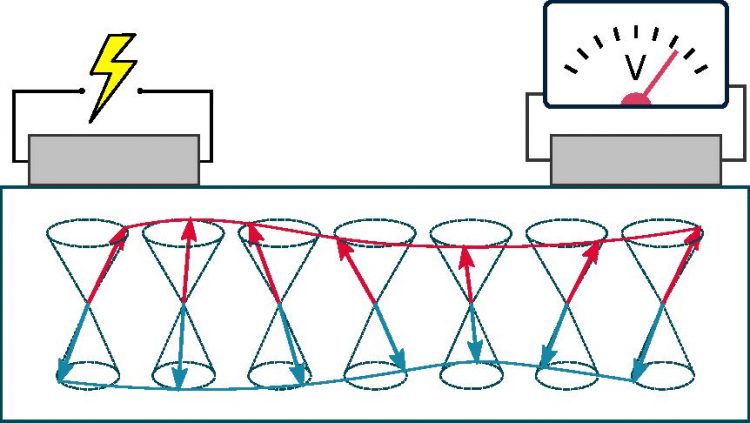New devices based on rust could reduce excess heat in computers

An electrical current in a platinum wire (l.) creates a magnetic wave in the antiferromagnetic iron oxide (red and blue waves) to be measured as a voltage in a second platinum wire (r.). The arrows represent the antiferromagnetic order of the iron oxide. Ill./©: Andrew Ross
Scientists have succeeded in observing the first long-distance transfer of information in a magnetic group of materials known as antiferromagnets.
These materials make it possible to achieve computing speeds much faster than existing devices. Conventional devices using current technologies have the unwelcome side effect of getting hot and being limited in speed. This is slowing down the progress of information technology.
The emerging field of magnon spintronics aims to use insulating magnets capable of carrying magnetic waves, known as magnons, to help solve these problems. Magnon waves are able to carry information without the disadvantage of the production of excess heat.
Physicists at Johannes Gutenberg University Mainz (JGU) in Germany, in cooperation with theorists from Utrecht University in the Netherlands and the Center for Quantum Spintronics (QuSpin) at the Norwegian University of Science and Technology (NTNU) in Norway, demonstrated that antiferromagnetic iron oxide, which is the main component of rust, is a cheap and promising material to transport information with low excess heating at increased speeds. Their study has been published recently in the scientific journal Nature.
By reducing the amount of heat produced, components can continue to become smaller alongside an increased information density. Antiferromagnets, the largest group of magnetic materials, have several crucial advantages over other commonly used magnetic components based on iron or nickel. For example, they are stable and unaffected by external magnetic fields, which is a key requirement for future data storage.
Additionally, antiferromagnet-based devices can be potentially operated thousands of times faster than current technologies as their intrinsic dynamics are in the terahertz range, potentially exceeding a trillion operations per second.
Fast computers with antiferromagnetic insulators are within reach
In their study, the researchers used platinum wires on top of the insulating iron oxide to allow an electric current to pass close by. This electric current leads to a transfer of energy from the platinum into the iron oxide, thereby creating magnons. The iron oxide was found to carry information over the large distances needed for computing devices.
“This result demonstrates the suitability of antiferromagnets to replace currently used components,” said Dr. Romain Lebrun from the JGU Institute of Physics. “Devices based on fast antiferromagnet insulators are now conceivable,” he continued.
Andrew Ross, one of the lead authors of the study, added: “If you are able to control insulating antiferromagnets, they can operate without excessive heat production and are robust against external perturbations.” Professor Mathias Kläui, senior author of the paper, commented on the joint effort: “I am very happy that this work was achieved as an international collaboration. Internationalization is a key aim of our research group and in particular of our Graduate School of Excellence Materials Science in Mainz and the spintronics research center Spin+X. Collaborations with leading institutions globally, like the Center for Quantum Spintronics and Utrecht University enable such exciting research.”
Image:
http://www.uni-mainz.de/bilder_presse/08_physik_komet_antiferromagnet_eisenoxid….
An electrical current in a platinum wire (l.) creates a magnetic wave in the antiferromagnetic iron oxide (red and blue waves) to be measured as a voltage in a second platinum wire (r.). The arrows represent the antiferromagnetic order of the iron oxide.
Ill./©: Andrew Ross
Related links:
https://www.klaeui-lab.physik.uni-mainz.de/ – Kläui-Laboratory at the JGU Institute of Physics
https://www.blogs.uni-mainz.de/fb08-iph-eng/ – Institute of Physics at JGU
http://www.mainz.uni-mainz.de/ – Graduate School of Excellence Materials Science in Mainz (MAINZ)
https://trr173.spin-engineering.de – Transregional Collaborative Research Center (SFB/TRR) 173 “Spin+X – Spin in its collective environment”
Read more:
http://www.uni-mainz.de/presse/aktuell/4356_ENG_HTML.php – press release “Construction set of magnon logic extended: Magnon spin currents can be controlled via spin valve structure” (14 March 2018)
Dr. Romain Lebrun
Condensed Matter Physics
Institute of Physics
Johannes Gutenberg University Mainz
55099 Mainz, GERMANY
phone: +49 6131 39-23637
fax: +49 6131 39-24076
e-mail: rolebrun@uni-mainz.de
Professor Dr. Mathias Kläui
Condensed Matter Physics
Institute of Physics
Johannes Gutenberg University Mainz
55099 Mainz, GERMANY
phone +49 6131 39-23633
e-mail: klaeui@uni-mainz.de
https://www.klaeui-lab.physik.uni-mainz.de/homepage-prof-dr-mathias-klaeui/
R. Lebrun et al., Tunable long-distance spin transport in a crystalline antiferromagnetic iron oxide, Nature, 13 September 2018,
DOI: 10.1038/s41586-018-0490-7
https://www.nature.com/articles/s41586-018-0490-7
Media Contact
More Information:
http://www.uni-mainz.de/All latest news from the category: Physics and Astronomy
This area deals with the fundamental laws and building blocks of nature and how they interact, the properties and the behavior of matter, and research into space and time and their structures.
innovations-report provides in-depth reports and articles on subjects such as astrophysics, laser technologies, nuclear, quantum, particle and solid-state physics, nanotechnologies, planetary research and findings (Mars, Venus) and developments related to the Hubble Telescope.
Newest articles

Properties of new materials for microchips
… can now be measured well. Reseachers of Delft University of Technology demonstrated measuring performance properties of ultrathin silicon membranes. Making ever smaller and more powerful chips requires new ultrathin…

Floating solar’s potential
… to support sustainable development by addressing climate, water, and energy goals holistically. A new study published this week in Nature Energy raises the potential for floating solar photovoltaics (FPV)…

Skyrmions move at record speeds
… a step towards the computing of the future. An international research team led by scientists from the CNRS1 has discovered that the magnetic nanobubbles2 known as skyrmions can be…





















